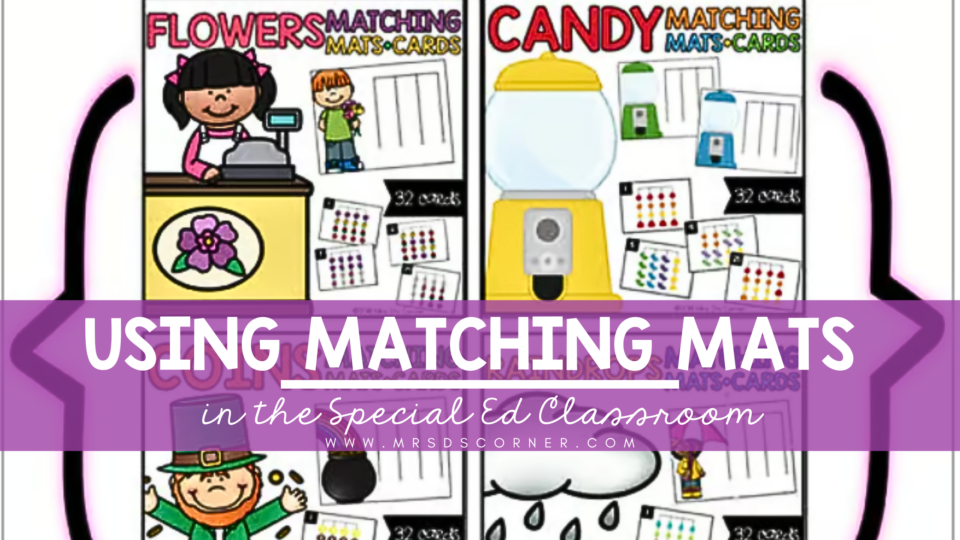Matching mats are a valuable educational resource that can be used to engage and enhance learning experiences for students across various grade levels and subjects. They work especially well for students in the special education classroom.


These mats provide a hands-on and interactive approach to teaching and reinforcing important skills such as pattern recognition, color identification, and matching. Let’s explore what matching mats are, the skills they cover, and how to effectively use them in the special ed classroom. Plus, at the end of the article, you can grab a free mat to use with your students!
What are Matching Mats?
Matching mats are typically sets of colorful and visually appealing activity cards that are designed to be used with corresponding mats or bases. The mats serve as a guide or template for students to place the activity cards or manipulatives in the correct positions based on specific criteria such as patterns or colors. Each mat is specifically designed to target a particular skill or concept, making them versatile educational resources.
Skills Covered by Matching Mats
The mats cover a wide range of skills, depending on the specific set being used. Some common skills that can be developed using matching mats include the following.
Pattern Recognition
These mats often feature activity cards with various patterns that students need to replicate on the mat. This helps students enhance their ability to identify and analyze patterns, an essential skill in mathematics and logical reasoning.
Color Identification
Many mats focus on color recognition, requiring students to match activity cards with specific colors to corresponding positions on the mat. This helps reinforce color identification skills and improves visual discrimination abilities.
Matching and Sorting
The mats can also be used to develop matching and sorting skills by providing students with sets of activity cards that need to be matched based on specific criteria. This helps improve cognitive abilities related to classification and sorting.
Fine Motor Skills
As students manipulate the activity cards and place them on the mats, they also engage their fine motor skills. This can help improve hand-eye coordination and dexterity.
Why Use Matching Mats?
Matching mats offer several advantages in the learning process. Here are some of them.
Hands-on Learning
The mats provide a hands-on learning experience that actively engages students in the learning process. This kinesthetic approach promotes better understanding and retention of concepts.
Visual and Tactile Stimulation
The vibrant colors and appealing designs of these mats capture students’ attention and provide visual stimulation. The tactile nature of manipulating the activity cards adds another layer of sensory engagement.
Differentiated Instruction
The mats can be easily adapted to accommodate students at different skill levels. Educators can choose mats and activity cards that match the individual needs of each student, making them an effective tool for differentiated instruction.
Independent Learning
I love using these types of mats for independent learning activities or incorporated into group activities and centers. This promotes independent thinking, problem-solving, and self-paced learning.
How to Use Matching Mats Effectively
To make the most of matching mats in the classroom, you have to teach students how to use them properly.
Introduce Properly
Explain the purpose of matching mats and demonstrate how they are used. Ensure that students understand the specific skill or concept they will be working on.
Start with Simpler Mats
Begin with mats with simpler patterns or fewer colors to build confidence and familiarity. Gradually increase the complexity as students become more comfortable.
Encourage Discussion
Encourage students to discuss their thinking process when completing the mats. This helps develop communication skills and allows for peer learning and collaboration.
Provide Feedback
Offer constructive feedback to students as they work on the mat activities. Highlight correct placements and help students identify errors or misconceptions.
Extension Activities
Use matching mats as a springboard for further exploration and reinforcement of concepts. Create additional activities or games that build upon the skills practiced using the mats.
Mrs. D’s Matching Mats
I am thrilled to share Mrs. D’s Matching Mats that I created to use in my classrooms and then share with you!
Colorful and Engaging
One of the standout features of the Matching Mats is their vibrant and colorful design. The captivating colors and attractive visuals instantly capture students’ attention, making learning more engaging and enjoyable. I found that when my kids liked the look of the resources I used, they were likelier to engage with them, hence why all of my Matching Mats are fun and colorful!
Support Diverse Learners
Drawing from my experience and understanding of diverse student needs, these mats are tailored to meet the requirements of all learners, including those with special educational needs. I took into consideration different learning styles and abilities to promote inclusivity and ensure that every student feels valued and supported in the classroom.
Versatile
The Matching Mats’s versatility is another reason they are an invaluable resource for teachers. They can be seamlessly integrated into various subjects and skills, such as math, language arts, science, or social studies. And there are plenty of activities for the holidays too! Whether you need a tool for hands-on activities, critical thinking exercises, or problem-solving tasks, these mats offer endless possibilities. You can quickly adapt them to different grade levels and use them as a part of your existing curriculum frameworks.
Get Your Matching Mats Now!
You can grab a free Matching Mat in the Resource Library and check out all of the Mrs. D’s Matching Mats HERE!
Matching mats are versatile teaching tools that promote active learning, critical thinking, and skill development in an engaging manner. By incorporating these mats into your teaching repertoire, you can create meaningful learning experiences that cater to diverse learners and promote academic growth across various subjects.

